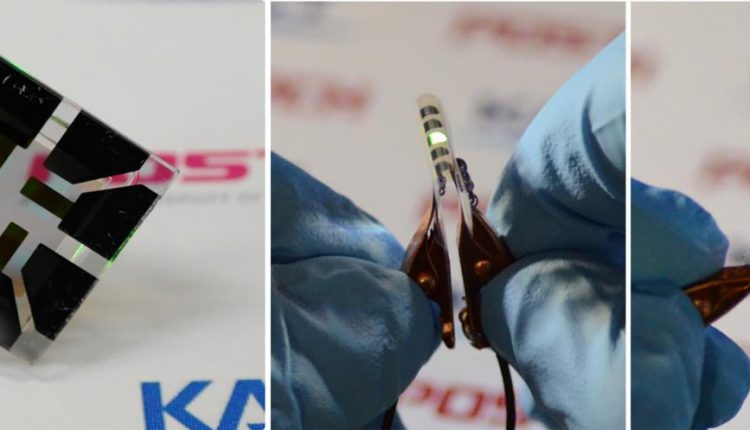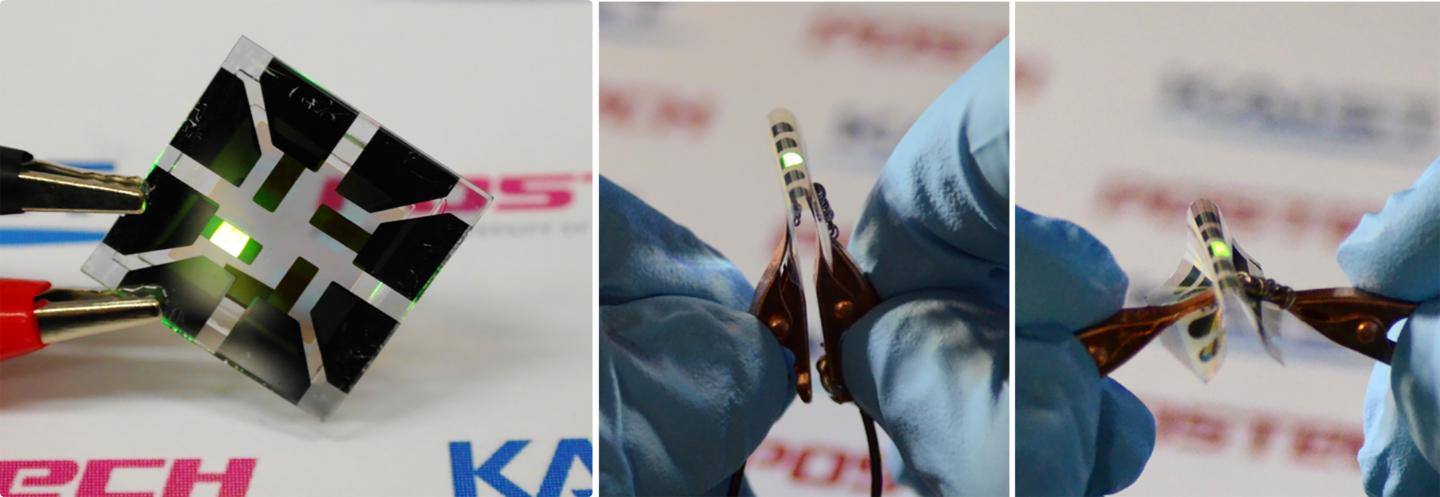
Team creates highly flexible OLEDs with graphene-based electrodes
Now that a team of researchers from the Korean Advanced Institute of Science and Technology has used a graphene-based transparent electrode to create flexible organic light-emitting diodes (OLEDs), our future could include thin and lightweight computers that can roll up like paper.
Flexible OLEDs built upon a plastic substrate are becoming quite popular in the tech world because of their use in next-generation displays that can be bent or rolled while still functional.
The team led by Professor Seunghyup Yoo from the School of Electrical Engineering, KAIST and Professor Tae-Woo Lee from the Department of Materials Science and Engineering, Pohang University of Science and Technology (POSTECH) developed the highly flexible OLEDs with excellent efficiency by using graphene as a transparent electrode (TE) which is placed in between titanium dioxide (TiO2) and conducting polymer layers.
How OLEDs work
OLEDs are stacked in ultra-thin layers on glass, foil, or plastic substrates. Multi-layers of organic compounds are sandwiched between two electrodes and when voltage is applied across the electrodes, electrons from the cathode and positive charges from the anode come toward each other and meet in the emissive layer (the layer that’s emitting the light). When the electron recombines with the positive hole, OLEDs emit light by releasing energy in the form of a photon. One of the electrodes in OLEDs is usually transparent, and depending on which electrode is transparent, OLEDs can either emit from the top or bottom.
Typically, OLEDs employ Indium-tin-oxide (ITO) as a transparent anode because of its high transparency, low sheet resistance, and well-established manufacturing process, but the material can be expensive and is brittle, which means its susceptible to cracks that come along with bending.

The researchers turned to graphene, a two-dimensional thin layer of carbon atoms tightly bonded together in a hexagonal honeycomb lattice. Graphene has efficient electrical, physical, and chemical properties, and its atomic thinness means that it can provide the flexibility and transparency needed.
While the material is a better alternative, so far the material have proven to produce just about the same level of efficiency as ITO-based OLEDs.
The team proposed a new device architecture that can maximize the efficiency of graphene-based OLEDs by fabricating a transparent anode in a composite structure in which a TiO2 layer with a high refractive index (high-n) and a hole-injection layer (HIL) of conducting polymers with a low refractive index (low-n) sandwich graphene electrodes.
This design induces a synergistic collaboration between the high-n and low-n layers in order to increase the effective reflectance of TEs. As a result, the enhancement of the optical cavity resonance is maximized. The optical cavity resonance is related to the improvement of efficiency and color gamut in OLEDs. At the same time, the loss from surface plasmon polariton (SPP), a major cause for weak photon emissions in OLEDs, is also reduced due to the presence of the low-n conducting polymers.
Using this approach, graphene-based OLEDs exhibited 40.8% of ultrahigh external quantum efficiency (EQE) and 160.3 lm/W of power efficiency, which, according to the team, is unprecedented in those using graphene as a TE.
The devices also remained intact and operated well even after 1,000 bending cycles at a radius of curvature as small as 2.3 mm.
“What’s unique and advanced about this technology, compared with previous graphene-based OLEDs, is the synergistic collaboration of high- and low-index layers that enables optical management of both resonance effect and SPP loss, leading to significant enhancement in efficiency, all with little compromise in flexibility,” said Yoo. “Our work was the achievement of collaborative research, transcending the boundaries of different fields, through which we have often found meaningful breakthroughs.”
The team envisions that the technology will pave the way to develop an OLED light source for highly flexible and wearable displays, or flexible sensors that can be attached to the human body for health monitoring.

Comments are closed, but trackbacks and pingbacks are open.